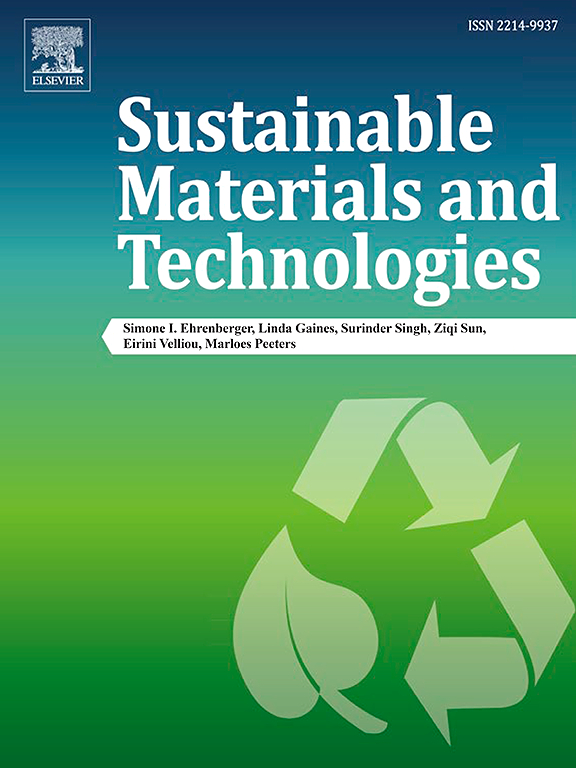土工合成材料加筋RCA在小体积道路中应用GSB层性能评价的室内研究
IF 8.6
2区 工程技术
Q1 ENERGY & FUELS
引用次数: 0
摘要
土工合成材料在土木工程中的重要性日益增加,这是由于它们能够提高道路、铁路和堤防等基础设施的性能。土工合成钢筋通过提供侧向约束和张拉膜作用来改善路面性能。对于路面应用,土工格栅和土工格室被广泛使用。另一方面,由于快速的城市化带来了重大的环境和物流挑战,建筑和拆除(C&;D)废物的产生正在增加。为了解决与C&;D废物有关的问题,过去已经进行了许多研究,通过机械和添加剂稳定技术来表征再生混凝土骨料(RCA)在路面颗粒层中的使用。然而,这些方法有局限性,包括需要专门的设备,劳动密集型的过程和固化时间。由于对RCA与土工合成加固在颗粒亚基(GSB)应用中的性能研究有限,本研究评估了RCA在加土工合成加固和不加土工合成加固的情况下在GSB中的性能,并将其与常规骨料(CA)的性能进行了比较。原型路面部分在无钢筋(UR)构造,土工格栅加固(CGG)、土工格室碎石垫层(公司治理文化),并结合geocell,基础土工格栅加筋(CGG + CGC)条件。通过反复荷载试验,监测路面段位移、路基水平竖向压力、沿钢筋方向应变。结果表明,RCA的表现与CA相当,支持其在GSB应用中的使用,并促进可持续实践。土工合成材料加筋路面的塑性位移比普通混凝土路面减少了0.13 ~ 0.41倍。CGG + CGC路段的交通效益比最高,CA为4.55,RCA为7.25。此外,土工合成纤维增强截面的残余压力比普通混凝土截面降低了0.14 ~ 0.39倍。应变分析表明,CGG + CGC截面的载荷分布优于单独CGC截面。该研究得出结论,RCA和土工合成材料的结合使用为路面工程提供了一种经济、可持续的解决方案,可以延长路面寿命,降低维护成本。本文章由计算机程序翻译,如有差异,请以英文原文为准。
Laboratory study on the performance evaluation of RCA reinforced with geosynthetics for GSB layer application in low volume roads
The increasing importance of geosynthetics in civil engineering has been driven by their ability to enhance the performance of infrastructure such as roads, railways, and embankments. Geosynthetic reinforcement improve the pavement performance by providing lateral restraint and tensioned membrane action. For pavement application, geogrids and geocells are widely used. On the other hand, the construction and demolition (C&D) waste generation is increasing owing to rapid urbanization posing significant environmental and logistic challenges. To address the issues related to C&D waste, numerous research has been conducted in the past to characterize recycled concrete aggregate (RCA) for its use in granular layers of pavements through mechanical and additive stabilization techniques. However, these methods have limitations, including the need for specialized equipment, labour-intensive processes, and curing period. Owing to the limited studies on the performance of RCA in conjunction with geosynthetic reinforcement in granular sub-base (GSB) application, this study evaluates the performance of RCA in GSB application with and without geosynthetic reinforcement and compare its performance with conventional aggregates (CA). Prototype pavement sections were constructed under unreinforced (UR), geogrid reinforced (CGG), geocell reinforced (CGC), and combination of geocell & basal geogrid-reinforced (CGG + CGC) conditions. Through repeated load tests, displacement of the pavement section, vertical pressure at the subgrade level, and strain along the reinforcement are monitored. Results showed that RCA performed comparable to CA, supporting its use in GSB application and promoting sustainable practices. Geosynthetic reinforced pavements exhibited reduced plastic displacement by a factor of 0.13 to 0.41 compared to UR sections. The CGG + CGC sections achieved the highest traffic benefit ratio (TBR) of 4.55 with CA and 7.25 with RCA. Additionally, geosynthetic reinforced sections showed reduced residual pressure by 0.14 to 0.39 times compared to UR sections. Strain analysis indicated superior load distribution in CGG + CGC sections over sections with CGC alone. The study concludes that the combined use of RCA and geosynthetics offers a cost-effective, sustainable solution for pavement engineering, promoting extended pavement life and reduced maintenance costs.
求助全文
通过发布文献求助,成功后即可免费获取论文全文。
去求助
来源期刊

Sustainable Materials and Technologies
Energy-Renewable Energy, Sustainability and the Environment
CiteScore
13.40
自引率
4.20%
发文量
158
审稿时长
45 days
期刊介绍:
Sustainable Materials and Technologies (SM&T), an international, cross-disciplinary, fully open access journal published by Elsevier, focuses on original full-length research articles and reviews. It covers applied or fundamental science of nano-, micro-, meso-, and macro-scale aspects of materials and technologies for sustainable development. SM&T gives special attention to contributions that bridge the knowledge gap between materials and system designs.
 求助内容:
求助内容: 应助结果提醒方式:
应助结果提醒方式:


